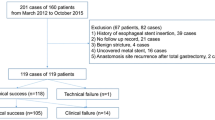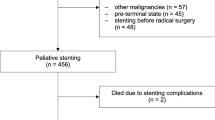Abstract
Background
Fully covered self-expanding metal stents (FCSEMS), unlike partially covered SEMS (PCSEMS), have been used to treat benign as well as malignant conditions. We aimed to evaluate the outcome of PCSEMS and FCSEMS in patients with both benign and malignant esophageal diseases.
Methods
Data were reviewed of all patients who underwent SEMS placement for malignant or benign conditions between January 1995 and January 2012. Patients with cancer were followed for at least 3 months, until death or surgery. Patients with benign conditions had stents removed between 4 and 12 weeks. Patient demographics, location and type of lesion, stent placement and removal, clinical success, and adverse events were analyzed.
Results
A total of 252 patients (mean ± standard deviation age 68.5 ± 14 years; 171 male) received 321 SEMS (209 PCSEMS, 112 FCSEMS) for malignant (78 %) and benign (22 %) conditions. Stent placement and removal was successful in 97.6 and 95.6 % procedures. Successful relief of malignant dysphagia was noted in 140 of 167 patients (83.8 %) and control of benign fistulas, leaks, and perforations was noted in 21 of 25 patients (84 %), but only 8 of 15 patients (53 %) with recalcitrant benign strictures had effective treatment. Fifty-six patients (22.2 %) experienced at least one stent-related adverse events. Migration was frequent, occurring in 61 of 321 stent placements (19 %), and more frequently with FCSEMS than PCSEMS (37.5 vs. 9.1 %, p < 0.001). FCSEMS, benign conditions, and distal location were the variables independently associated with migration (p < 0.001, p = 0.022, and p = 0.008). Patients with PCSEMS were more likely to have tissue in- or overgrowth than FCSEMS (53.4 vs. 29.1 %, p = 0.004).
Conclusions
Both PCSEMS and FCSEMS can be used in benign and malignant conditions; they are both effective for relieving malignant dysphagia and for closing leaks and perforations, but they seem less effective for relieving benign recalcitrant strictures. Stent migration is more common with FCSEMS, which may limit its use for the palliation of malignant dysphagia.


Similar content being viewed by others
References
Sharma P, Kozarek R (2010) Role of esophageal stents in benign and malignant disease. Am J Gastroenterol 105:258–273
Low DE, Kozarek RA (2003) Removal of esophageal expandable metal stents: description of technique and review of potential applications. Surg Endosc 17:990–996
Irani S, Kozarek R (2013) History of GI stenting: rigid prostheses in the esophagus. In: Kozarek R, Baron T, Song HY (eds) Self-expandable stents in the gastrointestinal tract. Springer, New York, pp 3–13
Kozarek R, Baron T, Song HY (2013) Self-expandable stents in the gastrointestinal tract. Springer, New York
Ross WA, Alkassab F, Lynch PM, Ayers GD, Ajani J, Lee JH, Bismar M (2007) Evolving role of self-expanding metal stents in the treatment of malignant dysphagia and fistulas. Gastrointest Endosc 65:70–76
Bethge N, Sommer A, Gross U, von Kleist D, Vakil N (1996) Human tissue responses to metal stents implanted in vivo for the palliation of malignant stenoses. Gastrointest Endosc 43:596–602
Ott C, Ratiu N, Endlicher E, Rath HC, Gelbmann CM, Schölmerich J, Kullmann F (2006) Self-expanding polyflex plastic stents in esophageal disease: various indications, complications, and outcomes. Surg Endosc 21:889–896
Uitdehaag MJ, Siersema PD, Spaander MC, Vleggaar FP, Verschuur EM, Steyerberg EW, Kuipers EJ (2010) A new fully covered stent with antimigration properties for the palliation of malignant dysphagia: a prospective cohort study. Gastrointest Endosc 71:600–605
Eloubeidi MA, Lopes TL (2009) Novel removable internally fully covered self-expanding metal esophageal stent: feasibility, technique of removal, and tissue response in humans. Am J Gastroenterol 104:1374–1381
Cotton PB, Eisen GM, Aabakken L, Baron TH, Hutter MM, Jacobson BC, Mergener K, Nemcek A, Peterson BT, PPetrini JL, Pike IM, Rabeneck L, Romagnuolo J, Vargo JJ (2010) A lexicon for endoscopic adverse events: report of an ASGE workshop. Gastrointest Endosc 71:446–454
Uitdehaag MJ, van Hooft JE, Verschuur EM, Repici A, Steyerberg EW, Fockens P, Kuipers EJ, Siersema PD (2009) A fully-covered stent (Alimaxx-E) for the palliation of malignant dysphagia: a prospective follow-up study. Gastrointest Endosc 70:1082–1089
van Boeckel PG, Dua KS, Weusten BL, Schmits RJ, Surapaneni N, Timmer R, Vleggaar FP, Siersema PD (2012) Fully covered self-expandable metal stents (SEMS), partially covered SEMS and self-expandable plastic stents for the treatment of benign esophageal ruptures and anastomotic leaks. BMC Gastroenterol 29:12–19
van Boeckel PG, Siersema PD, Sturgess R, Dwyer L, Raijman I, Hirdes MM, Vleggaar FP (2010) A new partially covered metal stent for palliation of malignant dysphagia: a prospective follow-up study. Gastrointest Endosc 72:1269–1273
Verschuur EM, Homs MY, Steyerberg EW, Haringsma J, Wahab PJ, Kuipers EJ, Siersema PD (2006) A new esophageal stent design (Niti-S stent) for the prevention of migration: a prospective study in 42 patients. Gastrointest Endosc 63:134–140
Verschuur EM, Repici A, Kuipers EJ, Steyerberg EW, Siersema PD (2008) New design esophageal stents for the palliation of dysphagia from esophageal or gastric cardia cancer: a randomized trial. Am J Gastroenterol 103:304–312
Conigliaro R, Battaglia G, Repici A, De Pretis G, Ghezzo L, Bittinger M, Messmann H, Demarquay JF, Togni M, Blanchi S, Filiberti R, Conio M (2007) Polyflex stents for malignant oesophageal and oesophagogastric stricture: a prospective, multicentric study. Eur J Gastroenterol Hepatol 19:195–203
Dua KS, Vleggaar FP, Santharam R, Siersema PD (2008) Removable self-expanding plastic esophageal stent as a continuous, non-permanent dilator in treating refractory benign esophageal stricture: a prospective two center study. Am J Gastroenterol 103:2988–2994
Holm AN, de la Mora Levy JG, Gostout CJ, Topazian MD, Baron TH (2007) Self-expanding plastic stents in treatment of benign esophageal conditions. Gastrointest Endosc 67:20–25
Bakken JC, Wong Kee Song LM, de Groen PC, Baron TH (2010) Use of a fully covered self-expandable metal stent for the treatment of benign esophageal diseases. Gastrointest Endosc 72:712–720
Senousy BE, Gupte AR, Draganov PV, Forsmark CE, Wagh MS (2010) Fully covered Alimaxx esophageal metal stents in the endoscopic treatment of benign esophageal diseases. Dig Dis Sci 55:3399–3403
Vanbiervliet G, Filippi J, Karimdjee BS, Venissac N, Iannelli A, Rahili A, Benizri E, Pop D, Staccini P, Tran A, Schneider S, Mouroux J, Gugenheim J, Benchimol D, Hébuterne X (2012) The role of clips in preventing migration of fully covered metallic esophageal stents: a pilot comparative study. Surg Endosc 26:53–59
Homs MY, Wahab PJ, Kuipers EJ, Steyerberg EW, Grool TA, Haringsma J, Siersema PD (2004) Esophageal stents with antireflux valve for tumors of the distal esophagus and gastric cardia: a randomized trial. Gastrointest Endosc 60:695–702
Verschuur EM, Steyerberg EW, Kuipers EJ, Siersema PD (2007) Effect of stent size on complications and recurrent dysphagia in patients with esophageal or gastric cardia cancer. Gastrointest Endosc 65:592–601
van Heel NC, Haringsma J, Wijnhoven BP, Kuipers EJ (2011) Endoscopic removal of self-expandable metal stents from the esophagus. Gastrointest Endosc 74:44–50
Repici A, Conio M, De Angelis C, Battaglia E, Musso A, Pellicano R, Goss M, Venezia G, Rizzetto M, Saracco G (2004) Temporary placement of an expandable polyester silicone-covered stent for treatment of refractory benign esophageal strictures. Gastrointest Endosc 60:513–519
Leers JM, Vivaldi C, Schafer H, Bludau M, Brabender J, Lurje G, Herbold T, Hölscher AH, Metzger R (2009) Endoscopic therapy for esophageal perforation or anastomotic leak with a self-expandable metallic stent. Surg Endosc 23:2258–2262
Fischer A, Thomusch O, Benz S, von Dobschuetz E, Baier P, Hopt UT (2006) Nonoperative treatment of 15 benign esophageal perforations with self-expandable covered metal stents. Ann Thorac Surg 81:467–472
Siersema PD, Homs MY, Haringsma J, Tilanus HW, Kuipers EJ (2003) Use of large-diameter metallic stents to seal traumatic nonmalignant perforations of the esophagus. Gastrointest Endosc 58:356–361
van Heel NC, Haringsma J, Spaander MC, Bruno MJ, Kuipers EJ (2010) Short-term esophageal stenting in the management of benign perforations. Am J Gastroenterol 105:1515–1520
Karbowski M, Schembre D, Kozarek R, Ayub K, Low D (2008) Polyflex self-expanding, removable plastic stents: assessment of treatment efficacy and safety in a variety of benign and malignant conditions of the esophagus. Surg Endosc 22:1326–1333
Adler DG, Fang J, Wong R, Wills J, Hilden K (2009) Placement of polyflex stents in patients with locally advanced esophageal cancer is safe and improves dysphagia during neoadjuvant therapy. Gastrointest Endosc 70:614–619
Disclosures
Dr. Low has received speaking honoraria from Boston Scientific, Inc. Dr. Kozarek serves as a consultant to Taewoong Medical with fees paid to Virginia Mason Medical Center. Taewoong Medical provided all stents used during the study period without charge. No other support was provided by any device or pharmaceutical company. Drs. Seven, Irani, Ross, Gluck, and Gan have no conflicts of interest or financial ties to disclose.
Author information
Authors and Affiliations
Corresponding author
Rights and permissions
About this article
Cite this article
Seven, G., Irani, S., Ross, A.S. et al. Partially versus fully covered self-expanding metal stents for benign and malignant esophageal conditions: a single center experience. Surg Endosc 27, 2185–2192 (2013). https://doi.org/10.1007/s00464-012-2738-x
Received:
Accepted:
Published:
Issue Date:
DOI: https://doi.org/10.1007/s00464-012-2738-x




